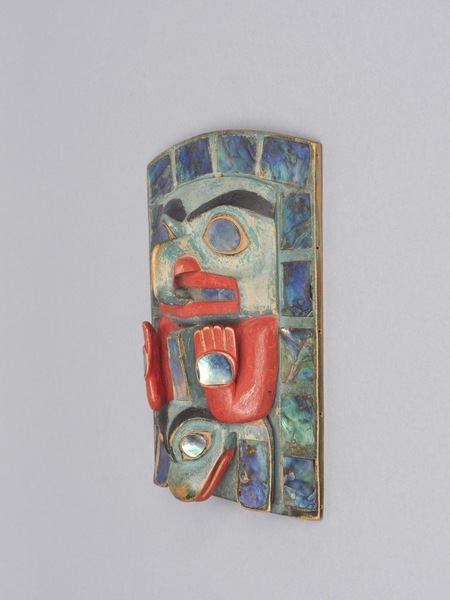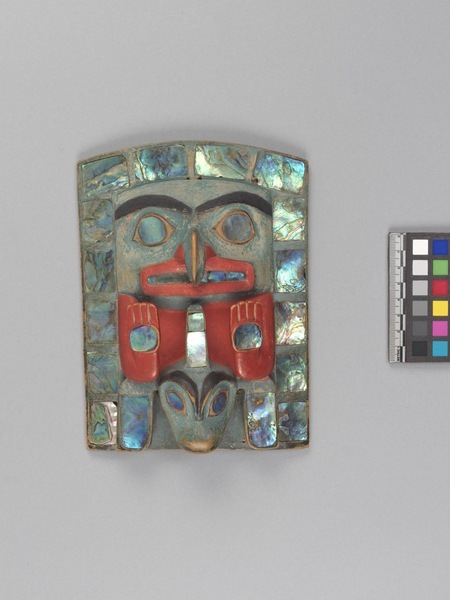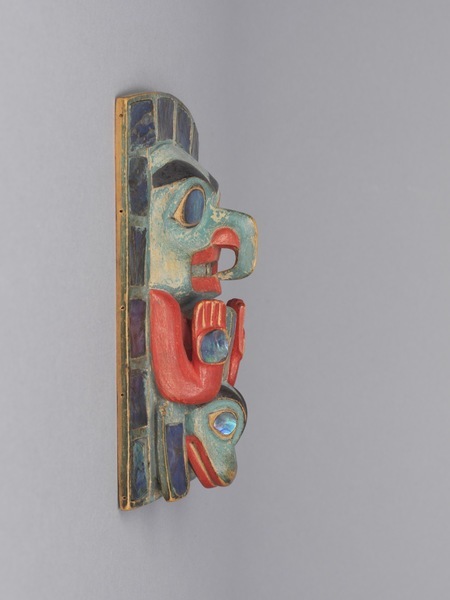Frontlet Item Number: 3261/4 from the MOA: University of British Columbia




Description
Rectangular carved frontlet with Thunderbird or other bird-being in relief; abalone inlay along both sides and across top, and used for accents on animal features. The bird has a recurved beak going into lower lip. Below the face are red human-like arms and hands with palms out, fingers upward, with abalone on each palm. The bird's mouth is open, showing a row of abalone teeth behind wooden incisors and red painted lips. The eyes are circles of abalone, under arched black brows. This supernatural being shares space with a small orca, whose dorsal fin rises upward and pectoral fins downward. Painted red, green-blue, and black. The rear of the frontlet is concave. Illegible hand writing on back surface.
History Of Use
Carved frontlets, or shakee.át among the Tlingit, are said to have originated on the northern Northwest Coast. They continue to be made and worn ceremonially as part of a Tlingit clan leader’s complete headdress – regalia to which the frontlet is sewn, and that includes a long train of white ermine skins as well as a crown or circlet of upright sea-lion whiskers and flicker feathers into which eagle down is placed, to be shaken out during dancing.
Narrative
Displayed in the "Box of Daylight" exhibition at the Seattle Art Museum in 1983. Previously part of the Ziff family collection. The blue-green paint is made of a native green-earth pigment highly valued by artists of the northern coast. The painter would have ground the pigment and mixed it with water before applying it with his brush. The combination of blue-green paint, Chinese red vermilion – introduced in the late 1700s by fur traders – and abalone shell traded north from California helped to proclaim the wearer’s status and treasured at.óow (clan crests, names, land, and more) that this regalia was made to display.
Item History
- Made in Alaska, USA between 1800 and 1840
- Owned by Elspeth McConnell before April 12, 2018
- Received from Elspeth McConnell (Donor) on April 12, 2018
What
- Name
- Frontlet
- Identification Number
- 3261/4
- Type of Item
- frontlet
- Material
- abalone shell, maple wood and paint
- Manufacturing Technique
- carved, inlaid and painted
- Overall
- height 19.2 cm, width 14.5 cm, depth 5.0 cm
Who
- Culture
- Tlingit
- Previous Owner
- Elspeth McConnell
- Received from
- Elspeth McConnell (Donor)
Where
- Holding Institution
- MOA: University of British Columbia
- Made in
- Alaska, USA
When
- Creation Date
- between 1800 and 1840
- Ownership Date
- before April 12, 2018
- Acquisition Date
- on April 12, 2018
Other
- Condition
- good
- Accession Number
- 3261/0004